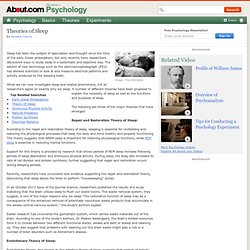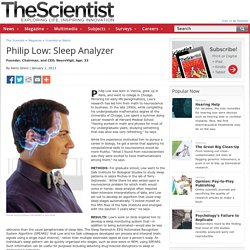

J. Neurosci. Authors Author contributions: E.F. and S.K. designed research; E.F. performed research; E.F., M.D., and T.R.B. analyzed data; E.F., M.D., T.R.B., and S.K. wrote the paper.

Lucid dreaming is a state of awareness that one is dreaming, without leaving the sleep state. Dream reports show that self-reflection and volitional control are more pronounced in lucid compared with nonlucid dreams. Mostly on these grounds, lucid dreaming has been associated with metacognition. Dreams, Telepathy, and Various States of Consciousness. Home » Dreams, Telepathy, and Various States of Consciousness Krippner, Stanley; Fracasso, Cheryl NeuroQuantology;Mar2011, Vol. 9 Issue 1, p1 Academic Journal An introduction to the journal is presented in which the authors discuss various reports published within the issue including "BioPhysics at Death: Three Hypotheses with Potential Application," by Michael Persinger and Linda St.

Scientists Demonstrate Remarkable Evidence Of Dream Telepathy Between People. Dream telepathy suggests that human beings have the ability to communicate telepathically with another person while they are dreaming.

This isn’t a new concept, scientific interest in telepathy dates back to the fathers of the psychoanalytic movement. Freud, for example, considered telepathy and the implications of it with regards to psychoanalytic thought. He also considered dream telepathy, or the telepathic influence of thought on dreaming on multiple occasions. Carl Jung believed in the telepathic hypothesis without question, and even developed a theoretical system to explain “paranormal” events of this nature. (2) All great minds seem to encourage the study of various types of non-physical phenomena.
“The day science begins to study non-physical phenomena, it will make more progress in one decade than in all the previous centuries of its existence.” – Nikola Tesla Experiments and Results During the experiments, there was usually a “telepathic sender” and a “telepathic receiver.” THE PHOSPHOTRON - Seno(9007).pdf.
Russell Foster: Why do we sleep? The Science of Lucid Dreaming and How to Learn to Control Your Dreams, Animated. The Secret Posture for Triggering Wake Initiated Lucid Dreams and Out-of-Body Experiences. A few years ago, I took a flight from Atlanta back to my home in San Francisco.

I was sleep deprived after a late night out with old friends. Lucid Dreaming. Review of Galantamine: the Lucid Dreaming Pill. So you’re considering the red pill… Galantamine has emerged as THE lucid dreaming pill.

This natural supplement has been used for centuries in China as a memory enhancer, and was even noted by the ancient Greeks for its powerful mind-inducing effects. Now we know that galantamine indirectly promotes dreaming sleep as well as lucid dreaming, which is the art of becoming self-aware in your dreams. There’s a lot of hype about galantamine, so I want to cover the basics about how it works on the brain, the studies that have proven its effectiveness, and my personal recommendations for experimentation with this safe and natural supplement. I also want to be brutally honest about some of the mild psychological and physical side effects as well.
Want to cut to the chase? Galantamine & Memory red spider lily (Lycoris radiata) Galantamine is found in the natural world in many plant sources, including the common daffodil (Narcissus pseudonarcissus). How Galantamine Works On your Brain Laberge’s results? Search Results lucid dreaming.
Theories of Sleep. Sleep has been the subject of speculation and thought since the time of the early Greek philosophers, but only recently have researchers discovered ways to study sleep in a systematic and objective way.

The advent of new technology such as the electroencephalograph (EEG) has allowed scientists to look at and measure electrical patterns and activity produced by the sleeping brain. While we can now investigate sleep and related phenomena, not all researchers agree on exactly why we sleep. How Do Dolphins Sleep? Dolphins can't breathe underwater, and so every every time a dolphin needs to breathe, it has to make the decision to come to the water surface to breathe and supply its lungs with oxygen.

Yet a dolphin might only be able to hold its breath for about 15-17 minutes. So how do they sleep? Theories of Sleep. Philip Low: Sleep Analyzer. Sleep background: Sleep?

Epigenomics? Re-Comprehend Sleep Genes are life’s primal organisms, evolved from RNA nucleotides by the ubiquitous natural selection. Originally they were active ONLY during daylight time, at the pre bio-metabolism era. Thus sleep is innate for all organisms, including for the genomes, which are the template organisms evolved by the RNAs for their own survival activities, as all life evolves for the purpose of supporting the RNAs survival. Decoding Dreams. ANDRZEJ KRAUZE“[I was] somewhere, in a place like a studio to make a TV program or something,” a groggy study participant recounted (in Japanese).

“A male person ran with short steps from the left side to the right side. Then, he tumbled.” The participant had recently been awoken by Masako Tamaki, a postdoc in the lab of neuroscientist Yukiyasu Kamitani of the ATR Computational Neuroscience Laboratories in Kyoto, Japan. He was lying in a functional magnetic resonance imaging (fMRI) scanner, doing his best to recall what he had been dreaming about.
“He stumbled over something, and stood up while laughing, and said something,” the participant continued. At first blush, the story doesn’t seem particularly informative. Knowing what is represented during sleep would help to understand the function of dreaming. “Decoding is very primitive,” Kamitani agrees, “but I think there are a lot of potentials.” Decoding Dreams.